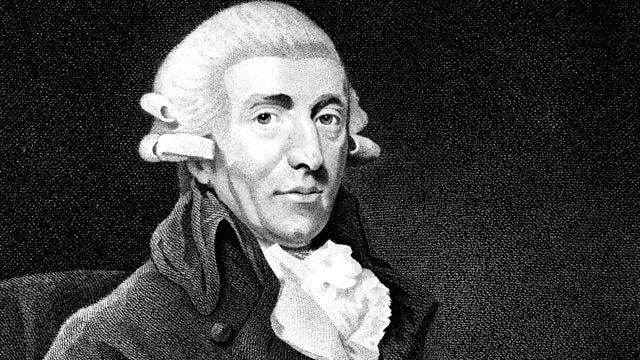
Haydn’s Symphony №103 is the eleventh of the twelve London, or Salomon Symphonies. Like the 102nd symphony, Haydn composed this symphony while living in London between 1794–1795. It is nicknamed the drumroll for the long timpani roll at the beginning of the symphony. It was premiered at the King’s Theatre on March 2, 1795, and it was very well received. Here’s a review of the premiere.
Another new Overture, by the fertile and enchanting Haydn, was performed; which, as usual, had continual strokes of genius, both in air and harmony. The Introduction excited deepest attention, the Allegro charmed, the Andante was encored, the Minuets, especially the trio, were playful and sweet, and the last movement was equal, if not superior to the preceding.
Haydn’s time in London was a particularly successful and happy time for him. His music had preceded him and the public had so greatly admired it that the impresario, violinist, composer and conductor Johann Peter Salomon persuaded Haydn to come to London to compose this set of symphonies.

This symphony is in four movements. As with Haydn’s Symphony №102, the beginning of the first movement begins with a slow Adagio, however in this symphony’s case it begins with a tympani “solo.” Improvisation was commonplace in the 18th century and there are many recordings that give the tympani a lot more to do than just play a simple role. An Allegro con spirito follows the slow introduction and like most symphonies that are composed in the key of E-flat, there is a very noble quality to the thematic material. The charming second movement, which was encored at the premiere, has a tempo marking of Andante più tosto allegretto. This is a very unique tempo indication that basically means an andante (walking tempo) that’s not too slow. The third movement Menuet also has a very nobile and regal quality to it, as it’s also in the home key of E-flat, and there’s a very noticeable emphasis on the downbeat of every bar. It makes me imagine a very strict dance master! The last movement is also an Allegro con spirito but there’s much more pastoral quality to it than with the first movement. It begins with a classic horn call, as if we’re about to go on a fox hunt, and the chase begins!
